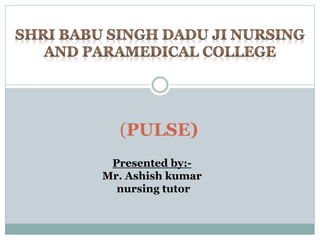
pulse-1.pptx
- 1. (PULSE) Presented by:- Mr. Ashish kumar nursing tutor
- 2. SPECIFIC OBJECTIVE DEFINITION OF PULSE SITE OF PULSE MEASURMENT ASSESSMENT OF PULSE FACTOR AFFECTING OF PULSE CHARACTERISTICS OF PULSE
- 3. DEFINITION OF PULSE The alternate expansion(raise)and recoil (raise)of the elastic arteries after each systole of the left ventricle creating a travelling pressure wave that is called the pulse. A healthy person normal pulse rate 60-100 b/min.
- 4. SITE OF PULSE MEASURMENT 1.TEMPORAL ARTERY-the site is above and lateral to eye where the temporal artery passes over the temporal bone of the head. 2.CAROTID ARTERY -at the side of the neck where the carotid artery runs between the trachea and the sternocleidomastoid muscle. Carotid asses less then 5-10 sec. 3.APICAL-At the apex of the heart between 4th and 5th intercostal space.
- 5. CONT… 4.RADIAL ARTERY -Radial artery located front of the wrist thumb side. 5.FEMORAL ARTERY -Inner aspect of upper thigh. 6.BRACHIAL ARTERY-at the inner aspect of the biceps muscles of the arm or medially in the anticubital . 7.POSTERIOR TIBIAL ARTERY-on the medial surface of the ankle.
- 6. CON….. 8.POPLITEAL ARTERY-where the popliteal artery passes behind the knee. 9.PEDAL (DORSAL PEDIS)-populated by feeling the dorsum upper surface of foot.
- 7. CON….
- 8. ASSESSMERNT OF PULSE A pulse is commonly assessed by palpation effecting or auscultation using stethoscope. The middle three finger are used for palpating all pulse site concept the apex of the heart ,A stethoscope is used for assessing apical pulse. Pulse is expressed in beat per minutes. Average pulse of an healthy adult is 72b/min and it range from 60-100 b/m.
- 9. CONT…. In some type of cardiovascular disease the heart rate and pulse rate can differ. The apical pulse rate may be his/her than the radial pulse and the difference is known as pulse deficit.
- 10. FACTOR AFFECTING OF PULSE 1.MEDICTION-some medication decrease the pulse. 2.EXERCISE-the pulse rate increase with muscular activity. 3.HYPOVOLEMIA/DEHYDRATION-loss of blood from the vascular system increase the pulse rate. 4.SRESS-stress increase the rate as well as the force of the heart beat.
- 11. CONT… 5.BODY TEMPREATUE-when the patient is in body temperature increase the pulse rate increase the pulse rate increase 10 b/min for every 1 degree Fahrenheit (0.56 degree Celsius) increase body temperature. 6.DISEASE CONDITION- loss of food ,shock increase the plus rate . 7.FOOD INTAKE-indigestion food cause increase pulse rate .
- 12. CONT… 8.AGE-the very young have a rapid pulse rate the adult have a normal range of 60-100 per minute the very old have relatively slow pulse rate
- 13. CHARACTERISTICS OF PULSE The characteristics of a pulse involves RATE-number of beats per minute RHYTHM-pattern or regularity of the beats. The length of time between beats should be same . VOLUME-amount of blood pumped with each beat. ARTERIAL WALL ELASTICITY- the artery wall should feel soft and flexible under the finger.
- 15. THANK YOU